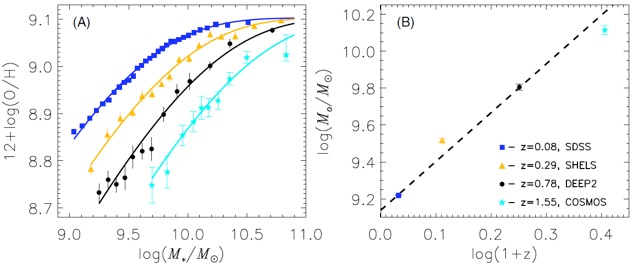
My dissertation work focused on the chemical evolution of star-forming galaxies. The most important observational and theoretical results are presented in Zahid et al. (2014).
All the heavy elements in the universe are formed by massive stars within galaxies. These heavy elements are recycled back into the interstellar medium of galaxies via stellar winds and supernovae. Observations of nebular emission allow us to measure the abundance of heavy elements in the gas-phase of galaxies out to high redshifts. These observations provide important constraints for gas flows in and out of galaxies and star formation, key processes governing the formation and evolution of galaxies. The gas-phase oxygen abundance scales with stellar mass such that more massive galaxies exhibit higher gas-phase oxygen abundance. This relation is known as the mass-metallicity (MZ) relation and is a key scaling relation for understanding galaxy evolution.
(A) Cosmic evolution of the MZ relation. The MZ relations are derived from consistently analyzed samples of galaxies observed at z < 1.6. The MZ relation has a power-law slope at low stellar masses and begins to saturates at large stellar masse. We fit the MZ relation with a model which is the solution of the differential equation of galactic chemical evolution. (B) The evolution of the MZ relation can be quantified by a single parameter which is the stellar mass where the MZ relation begins to saturate. We refer to this parameter as the turnover mass.
If I normalize stellar mass to the turnover mass, I find a single redshift independent relation.

I refer to the relation above as the universal metallicity relation. By comparing the fit parameters to the equations of galactic chemical evolution I conclude that there is a universal relation between the gas-phase oxygen abundance and stellar-to-gas-mass ratio followed by galaxies at z<1.6. The MZ relation is a projection of this relation.

The schematic shown above illustrates the three regimes of galactic chemical evolution. In the gas-rich regime, galaxies have gas mass which are greater than stellar masses; they evolve almost as closed boxes. In the gas-poor regime, the stellar mass of galaxies exceeds the gas mass. In this regime, the metallicity of the ISM becomes a significant fraction of the oxygen yield. Metallicities being to saturate at higher metallicities because a larger and larger fraction of the ISM metals become locked up in low mass stars forever. In the gas-depleted regime, galaxies have consumed nearly all their gas and have reached metallicity such that the amount of metals created by high mass stars and returned to the ISM exactly equals the amount of metals locked in low mass stars forever. The metallicity can not increase beyond this point and thus saturates.
This model has important implications for the cosmological evolution of gas in the universe. It also provides a framework for the use of metallicities as a probe of gas flows in galaxies. If you are interested, more details can be found in the paper or please feel free to contact me.
